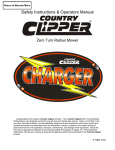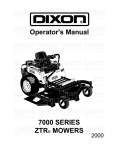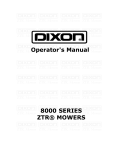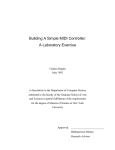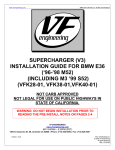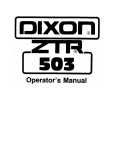Download Dixon 7000 Specifications
Transcript
TABLE OF CONTENTS I. OWNER INFORMATION Warranty Information -------------------------------------------- || Specifications------------------------------------------------------- ||| II. SAFETY Accident Patterns ------------------------------------------------------1 Safety Instructions and Recommendation -----------------------1 Safety Interlock Systems ---------------------------------------------3 III. START UP AND OPERATION Checklist Before Operation -------------------------------------------3 Control Locations-----------------------------------------------------------4 Operation ----------------------------------------------------------------- 4 Mowing Recommendations------------------------------------------- 6 VI. MAINTENANCE Maintenance Schedule ------------------------------------------------6 Maintenance Instructions -------------------------------------------- 7 Leveling the Deck-------------------------------------------------------10 Raising and Lowering Deck for Servicing ------------------------11 Trouble Shooting Checklist ------------------------------------------13 Wiring Schematic--------------------------------------------------------15 P-11408 (2/99) DIXON LIMITED WARRANTY POLICY - HYDRO-GEAR MODELS WARRANTY: Dixon Commercial Warranty term is for a period of one (1) year from date of purchase or 400 hours of use, whichever occurs first. Mowers used for residential homeowner applications (used only at owner's primary place of residence) are warranted for two (2) years from date of purchase or 400 hours of use, whichever occurs first. DIXON ZTR MOWERS ARE WARRANTED AGAINST DEFECTS IN MATERIALS AND WORKMANSHIP AND PROVIDES FOR REPLACEMENT OR REPAIR OF PARTS INCLUDING LABOR COSTS. THIS WARRANTY IS SUBJECT TO THE FOLLOWING CONDITIONS AND LIMITATIONS: 1. Warranty applies only to original retail purchaser of new and unused mower and accessories. 2. All Dixon warranty must be accomplished by authorized Dixon dealers and in accordance with Dixon warranty policy and allowances. All warranty claims must be approved by Dixon Industries, Inc. 3. Battery warranty. Limited to 90 days from date of purchase. 4. Accessories Warranty (Grass Catchers, Snow Blades, Tie Rakes, Covers, etc.): Limited to 90 days from date of purchase. 5. Warranty does not apply to damage in transit or incidents of misuse, negligence, accidents, or alteration. The use of parts or components other than those supplied by Dixon Industries, Inc. VOIDS ALL WARRANTY. 6. The following items are not covered by this warranty policy: (a) Pick up and delivery charges for transportation of mower to and from an Authorized Dixon Dealer's place of business. (b) Routine maintenance or adjustments. (c) Belts / chains / sprockets / cutting blades. (d) Engines - All engines used on Dixon ZTR mowers are warranted by each individual engine manufacturer. (e) Any cost or expense of providing substitute equipment while repair work is being performed on a warranted mower. 7. There is no other express warranty. Implied warranties, including those of merchantability and fitness for a particular / purpose, are limited to the dame duration of the express warranty, and to the extent permitted by law and all implied warranties are excluded. Liabilities for consequential damages under any and all warranties are excluded. WARRANTY VALIDATION: At the time of sale, selling dealer must review each portion of this warranty document, complete the information section below, secure customer's signature and send copy to Dixon Industries, Inc. SEE DEALER FOR DETAILS n P-11408 (2/99) SAFETY INSTRUCTIONS AND RECOMMENDATIONS ACCIDENT PATTERNS TO AVOID I. II. III. IV. V. CONTACT WITH THE ROTATING BLADE -- This accident usually happens when the operator is clearing the discharge chute of grass, (especially when the grass is wet), or when the operator adjusts the machine without turning it off and waiting for the blades to completely stop. 1. with the Zero Turning Radius Mower should be trained in its proper use and warned of its dangers. Before operating, adjusting, or servicing the Zero Turning Radius Mower they should read and understand this entire manual and the engine owner's manual. PROPELLED OBJECTS - Sticks, rocks, wires, and other objects can be propelled out through the discharge chute or from under the mower housing. Bystanders are particularly vulnerable. GRASS CATCHER OR GUARD - The mower shall not be operated without either the entire grass catcher or guard in place. 2. 3. OVERTURNING - This happens when riding mowers are used on steep slopes, embankments or hills. The operator in these cases can come in contact with the blades or sustain injuries during a fall. MOWER RUNNING OVER THE VICTIM ~ This usually happens when a riding mower is driven in reverse. The accident victims are most often young children whom, unseen by the operator of the mower, were in the area being mowed. PEOPLE WHO OPERATE, SERVICE, OR ARE OTHERWISE ASSOCIATED AVOID CONTACT WITH MOVING PARTS. Keep hands and feet from under mowing deck and away from blades at all times. Turn engine (motor) off if you must unclog the chute. AVOID HILLS AND SLOPES. Use .extreme caution when mowing up or down slopes. NEVER mow across the face of a slope. If a slope must be ascended, back up the slope; drive forward when descending. Reduce ~ speed and use caution to start, stop and maneuver. To prevent loss of control on a slope avoid sharp turns, sudden changes in direction, and sudden stops and starts. 4. DISENGAGE POWER TO MOWER BEFORE BACKING UP. Do not mow in reverse unless ABSOLUTELY necessary and then only after turning around and observing the entire area behind the mower. Go slowly. Most "running over victim" accidents occur in reverse. 5. BEGINNING OPERATORS SHOULD LEARN HOW TO STEER the Zero Turning Radius Mower before attempting to mow. Start with slow engine speed and drive without the blades engaged in an open area until comfortable with the machine. "6. KNOW HOW TO STOP QUICKLY. Know the location and operation of every control, especially how to brake and how to disengage the mower blades. P-11408 (2/99) 7. DO NOT MOVE STEERING CONTROL LEVERS from forward position to reverse position rapidly. The speed and/or direction of travel is affected instantly by movement of the Steering Control Levers. 8. DO NOT ALLOW CHILDREN TO OPERATE MOWER. Do not allow others who have not had instruction to operate mower. 9. ALWAYS TURN ENGINE OFF AND 10. several minutes after running. Always make sure the gas cap is in place. REMOVE KEY before leaving the mower to prevent children and inexperienced operators from starting the engine. Never leave the mower unattended with engine running. Always wait for all moving parts and all sounds to stop before leaving operator's seat. 11. NEVER CARRY PASSENGERS. 12. KNOW THE AREA YOU ARE TO MOW. Watch for hidden danger such as rocks, roots, sticks, holes, bumps, and drop-offs, etc. Before mowing, pick up all debris in area to be mowed. Sharp and hard objects can be propelled at a high speed and can act like shrapnel. Walk through tall grass BEFORE MOWING to make sure there are no hidden dangers. Mow higher than desired in tall grass to expose any hidden objects and/or obstacles, clean the area, and then mow to the desired height. NEVER REFUEL A MOWER INDOORS. Allow the engine time to cool before refueling. Unseen vapors may be ignited by a spark. Always clean up spilled gasoline. Never run the engine indoors in a garage or any other closed building. Allow engine to cool before storing in any enclosure. The engine exhaust and gasoline fumes are dangerous. 14. DO NOT SMOKE AROUND THE MOWER or the gasoline storage container. Gasoline fumes can easily ignite. 16. KEEP GASOLINE IN A WELLVENTILATED AREA away from your living quarters and in tightly-capped safety cans. Never store mower with gasoline in the tank inside a building where fumes may reach open flame or spark. 17. DISENGAGE BLADES, STOP ENGINE AND REMOVE IGNITION KEY before any servicing. Be sure all moving parts and all sounds have stopped. Let engine cool and disconnect the spark plugs so the engine cannot start by accident. A SLIGHT ROTATION OF THE BLADES COULD START THE ENGINE. 18. KEEP ALL NUTS, BOLTS, AND SCREWS TIGHT to be sure equipment is in safe working condition, especially blade mounting bolts. 19. VEHICLE SHOULD BE STOPPED WEAR STURDY, ROUGH-SOLED WORK SHOES AND CLOSE-FITTING SLACKS AND SHIRTS. Never operate mower in bare feet, sandals or sneakers. 13. 15. AND INSPECTED FOR DAMAGE after striking a foreign object and the damage should be repaired before restarting and operating the equipment. Stop immediately and check for damage or loose parts if mower should start vibrating. 20. projecting objects. 21 22. 23. NEVER REMOVE THE FUEL CAP or DISENGAGE BLADES BEFORE DRIVING ACROSS WALKS or KEEP SAFETY DEVICES AND GUARDS IN PLACE. If any of the safety switches become inoperable, have them repaired immediately. DO NOT STEP OR STAND ON THE MOWER HOUSING. Stop or stand only on the foot deck. WATCH OUT FOR TRAFFIC near roadways and when crossing roads. add gasoline to a running or hot engine that has not been allowed to cool for 24. 2 DO NOT USE MOWER WHEN GRASS IS WET OR SLIPPERY. P-11408 (2/99) 25. MOW ONLY DURING DAYLIGHT. 26. THIS MACHINE IS NOT MEANT FOR HIGHWAY OR STREET USE. It is not CHECKLIST BEFORE OPERATION a recreational vehicle and it should not be operated as such. 27. 1. Make sure fuel tank is full. Use regular unleaded gasoline (see engine owner's manual for more details). ALWAYS DISENGAGE THE MOWER BLADE CLUTCH when transporting. SAFETY INTERLOCK SYSTEM Your Zero Turning Radius Mower is equipped with switches interlocked for your safety. 1. The mower blades must be disengaged before engine will start. 2. 2. The Steering Control Levers must be in the neutral "OUT" position before the engine will start. Make sure dirt and foreign matter is kept out of gas tank. Use a clean funnel and gas can. 3. Do not mix oil with gasoline. 3. The engine will stop if the mower blade clutch is engaged when the operator leaves the driver's seat. 4. Do not use white, high test or premium gasoline. Do not use de-icers, carburetor cleaners, or other such additives. 4. The engine will stop if the Steering Control Levers are not in the neutral "OUT" position when the operator leaves the driver's seat. 5. Check the crankcase oil level. Make sure the engine is off. The mower should be parked on a level area. Do not overfill. (See your engine manual for more detailed instruction.) 5. The engine will stop if the brake is "SET" and the Steering Control Levers are moved to the "IN" position. 6. Check the hydrostatic transmission oil level. (See "Maintenance" section of this manual.) 7. Check battery fluid level. The engine will stop if the brake is "SET" and the mower blade clutch is engaged. 8. Inspect V-belts. 9. Check tire pressure: 6. Model All Models 3 Front tires 12psi Rear tires 12psi 10. Make sure underside of mower deck is free of grass. 11. Make sure mower blades are sharp and secured tightly. P-11408 (2/99) 12. 13. Clean the air intake screen on the engine if necessary. 3. Perform any other maintenance as it becomes necessary. (See the "Maintenance" section of this manual.) 4. IMPORTANT: Before cutting grass, clutch must be broken-in as follows: With engine at full RPM engage deck until blades come to full speed and then disengage until blades come to a complete stop. Repeat 10 times to seat clutch properly. DISENGAGE MOWER BLADE CLUTCH by moving clutch switch to "OFF" position. PULL ENGINE CHOKE CONTROL to full position for cold starts. 5. SET ENGINE THROTTLE TO 1/2 THROTTLE. 6. TURN IGNITION KEY to "START' position and release to "RUN" as soon as engine starts. NOTE: Prolonged cranking will damage starter motor and shorten the battery life. 7. ADJUST ENGINE THROTTLE AND CHOKE for desired engine smoothness and speed. NOTE: When mowing, always run engine at full throttle. 8. RELEASE PARKING BRAKE. Push brake lever down to release. 10. TO DRIVE: Move the Steering Control Levers to the "IN" position. Move the Steering Control Levers forward to move forward. Increasing forward movement of the Steering Control Levers will increase the speed of travel. To reverse the direction, pull the Steering Control Levers slightly back. To turn, move one Steering Control Lever slightly ahead of the other. To turn on a zero radius axis, go slowly and move one Steering Control Lever forward and one Steering Control lever rearward. (For a right hand turn the left hand Steering Control lever will be ahead of the right hand Steering Control. For a left hand turn the right hand Steering control will be ahead of the left hand Steering Control.) OPERATION 1. MOVE STEERING CONTROL LEVERS TO neutral "OUT position. 2. SET PARKING BRAKE. Pull up to set. 4 P-11408 (2/99) D. Slow engine speed with throttle to slowest position. E. Turn ignition key to "OFF" (left) position. F. Remove the key and wait for all movement and all sound to cease before dismounting. 11. BRAKING: To brake mower, gently move the Steering Control Levers in the direction opposite to travel. If the parking brake is engaged with the Steering Control Levers in the "IN" position the engine will stop. 12. CUTTING HEIGHT ADJUSTMENT: With the Cut Height Adjustment Lever latched into the top cut height latch. Insert Cut Height Stop Pin to desired cutting height. Pull Cut Height Adjustment Lever rearward and then to the right to clear top cut height latch. Lower Cut Height Adjustment Lever until it rests on Cut Height Stop Pin. 13. ENGAGE MOWER BLADE CLUTCH: 14. TO STOP: A. Move Steering Control Levers to neutral position and then to the "OUT" position. 15. TO FREE WHEEL MACHINE: UNLOCK TRANSMISSION: The transmission release levers are located on each side of the mower behind the rear drive axles and below the engine mounting plate. Lift the levers slightly, push them forward and then down to release the transmissions for free wheeling. To engage the transmissions lift the levers slightly, pull them to the rear and then down. NOTE: The tractor should never be pulled at more than 2 miles per hour or for any appreciable distance. Set the Blade Clutch Switch to the "ON" position. The engine will not start if the blade clutch is engaged. If the operator is not in the seat, the engine will stop if the clutch is engaged. B. Disengage the mower blade clutch by moving the clutch to the "OFF" position. C. Set the parking brake.'" 5 P-11408 (2/99) MOWING RECOMMENDATIONS 1. Keep mower blades sharp. 2. Make sure deck and discharge are clean. 3. When mowing tall grass, make two passes, mowing off 1/2 of the desired cut on the first pass, and then the desired height the second pass. Check for hidden dangers first. 4. Go slowly for trimming. 5. Always cut grass with the engine at full throttle speed. This "ENGINE" speed allows the cutting blades to operate at optimum cutting speed. Control "GROUND" speed with the Steering Control Levers. 6. Vary ground speed to suit conditions (i.e. go slower in tall thick grass, on hills, wet conditions, etc.). Replace decals when illegible. Write factory for free replacement. MAINTENANCE SCHEDULE , SERVICE WHEN Check crankcase oil level ————————————————————————-- before each use Clean grass from Hydrostat fans and cooling fans ———————————---— before each use Check air intake screen ——————————————————————----——— after each use Clean grass under deck ————————————————————————---— after each use Check tire pressure ———————————————————————————— every 10 hours Check battery fluid ———————————————————-——-———————every 10 hours Sharpen mower blades ——————————————————————————--------—— every 10 hours Clean air filter pre-cleaner element ———————————————------——— every 25 hours Check Hydrostatic transmission fluid ———————————————————— every 25 hours Check drive belts ————————————————————————————— every 50 hours (20 hours break-in) Service Air Cleaner Filter Element ——————————————————— every 100 hours Change engine crankcase oil ———————————————————————1QC hours oil filter ———————————————————----------—————— 200 hours Change Hydrostat oil and oil filter ————————————————————— every 500 hours (100 hours break-in) Replace air filter element ———————————————————————------— annually or 500 hours Check spark plugs ———————————————————————————— annually or 5 00 hours Service battery ——————————————————————————------——— annually or 500 hours 6 P-11408 (2/99) MAINTENANCE INSTRUCTIONS 1. ENGINE: 3. Correct tire pressure is essential for efficient operation of the mower. Check tire pressure as requested in the maintenance schedule. Inflate tires to the pressures listed below: For complete maintenance and operating information for your engine, please refer to your engine operating and maintenance instructions furnished by the engine manufacturer and included in your Dixon Zero Turning Radius Mower information packet. NOTE: Air intake screen must be kept clean. If plugged, engine may be seriously damaged by over heating. 2. TIRES: Lug nuts should be checked regularly for tightness. BATTERY: ~*. MOWER BLADES: Check sharpness of mower blades after every 10 hours of operation. To sharpen blades proceed as follows: Keep the electrolyte level above the plates in each cell by adding distilled water as it becomes necessary. Add water just before operating the mower to mix the water with the solution. Be careful not to overfill the battery - the electrolyte solution is corrosive and can cause damage to surrounding metal parts if it should spill. When taking the battery out of the mower for servicing, make sure to connect the cables to the battery exactly as they were prior to removal. Always disconnect the ground (-) wire first and always reconnect the ground (-) wire last. A. Remove bolt, lockwasher, and cup washer mounting blade on shaft. Remove blade. B. Blades should be discarded when worn excessively. Keep the battery clean. Remove the corrosion around the battery terminals by applying a solution of one part baking soda to four parts water. Coat all exposed terminal surfaces with a light layer of grease or petroleum jelly to prevent corrosion. NOTE: At temperatures below 32 degrees F (0 degrees C) the full charge state must be maintained to prevent cell electrolyte from freezing and causing permanent battery damage. C. Sharpen blades with a hand file, electric grinder or blade sharpener. Wear gloves and eye protection when sharpening. Grind blade at original 25 degree bevel. 7 P-11408 (2/99) D. Check balance of blade by positioning the blade on a nail or blade balance pedestal. Grind the blade on the end that is heavier until both sides balance. Check the oil level in hydrostatic transmission oil reservoir after every 25 hours of usage. Clean the oil reservoir cap and the area around it prior to removal. Check the oil level on the dipstick. The proper oil level should register between the marked hole on the dipstick and the end of the dipstick. Replenish as needed with 20W-50 Motor Oil. DO NOT OVER FILL. When checking the oil level, be very careful to keep the reservoir clean E. Install blade, cup washer, lockwasher, and bolt. Make sure to tighten bolt to 60 ft.lbs. 5. V-BELTS: There are 3 V-belts on your Dixon Zero Turning Radius Mower. They should be checked every 50 hours. Replace any belts found to be in poor condition. All belts are equipped with spring loaded belt tighteners and do not require tightening adjustments. 6. Change the oil in the reservoir and hydrostatic transmission filter after the first 100 hours of use, then every 500 hours after that. Remove the filter and be sure all oil has drained from the reservoir. Replace with new filter (P/N 7252) and 20W-50 Motor Oil. LUBRICATION: A. Engine: Follow engine manufacturer's recommendation. B. Deck Spindles: Lubricate with 3 "shots" only, every 100 hours. C. Hydrostatic Transmission & Filter: Follow instructions listed below. 7. PARKING BRAKE ADJUSTMENT: 8 A. With the brake handle in the "RELEASE" position and the actuating lever against the stop, remove the cotter pin from the castle nut. Insert a 0.010 feeler gauge between the brake disc and the brake puck. Tighten the castle nut with the feeler gauge inserted until the gauge fits snugly«between the disc and puck. The gap should not be so tight that the feeler gauge cannot be reinserted after removal. Back the castle nut to the closest pin hole and reinsert the cotter pin. P-11408 (2/99) D. Adjusting for Straight Forward Tracking: 8. STEERING CONTROL ADJUSTMENTS A. To Adjust Neutral: a. Remove the fender skirts from each side of the machine. b. Block up the unit so that the Drive Wheels are off the ground. c. Start the engine and run at a fast idle with the Steering control levers in the "out" position. d. Loosen the locknuts tightened against the rod end ball joints in the Upper Linkage Assembly. (Note: One of these is a left hand nut and will have to be turned backwards.) e. Adjust the Neutral Position by turning the rod in the upper linkage until the wheel stops turning. f. Retighten the nuts on the Upper Linkage Assembly and check to see that the drive wheel is still not turning. g. Repeat steps 1-6 for the other side. h. Shut off engine before removing the blocks. In a large open area, actuate the control handles into the full forward position. If the mower veers in either direction Left for Right some adjustment is necessary. a. If the mower veers to the right, then the right hydrostat needs to be sped up. If the mower veers to the left, then the left hydrostat need to be sped up. b. Stop the machine and shut off the engine. c. Slightly loosen the bolt at the lower end of the upper linkage assembly on the side that is slower. Using a 1/8" alien wrench turn the setscrew 1/4 turn in. It may take several test drives to get the mower to track straight forward. d. Once the tracking is to the operators liking, completely tighten the bolt on the control linkage assembly that was loosened earlier. e'. Recheck to make sure neutral adjust has not been effected, see procedure A. B. To Adjust "IN" Position of the Steering Controls: a. Remove the 2 Front Bolts, Lockwashers, and Washers which hold the Fender Cap. b. Pull the boot from the hole in the fender cap, exposing the cast iron lever. c. Using a 5/32° Alien Wrench, turn the setscrew to adjust the stop. d. Replace the Boot into the hole in the Fender Cap. c. Replace the 2 Front Bolts, Lockwashers, and Washers. C. To Align Handles: Sit on the seat and push the control levers full forward and full backward. If the ends do not match the handles maybe adjusted as follows: a. Locate Setscrew stops in the Steering Control Lever Base which stop the lever in each direction. (Note: The one at the rear is the stop for FWD and the one in the front is the stop for REV.) b.-Adjust setscrew stops so that handles line-up together when shifted full forward and full reverse. *' 9 P-11408 (2/99) 9. HYDROSTATIC TRANSMISSIONS: 11. Before each use, check to be sure that the cooling fins of the hydrostatic transmissions are clean. Excessive accumulation of oil, dirt, or trash may cause the transmissions to overheat. NEVER WASH ACROSS TOP OF RESERVOIR with water or steam. Fill reservoir as required per the maintenance schedule listed in this book. 10. LEVELING THE DECK: A. Set the tire pressure on all four tires B. Move the tractor to a hard, level surface (i.e. Concrete or blacktop). Place a 2 x 4 board under all four comers of the deck shell, just inside of the anti-scalping wheels. Lower the deck down onto the boards. The deck must rest on the boards, NOT the anti-scalping wheels.. Adjust the deck hangers longer or shorter until the deck "just" comes off of the boards. Remove the boards and verify that the deck is hanging on all four deck hangers, re-adjust if necessary. Lock the jam nuts on the two front deck hangers. (NOTE: the two rear deck hangers will be easier to adjust if the fender skirts are removed). HYDROSTAT DRIVE BELT REPLACEMENT PROCEDURE: (The hydrostatic drive is equipped with an automatic, anti-backlash belt take-up) A. Remove the 3/8° bolt lockwasher, heavy washer, and spring, from the rear of the assembly. B. Squeeze the clamp latch to release the clamp, allowing the idler arm/pulley to swing forward towards the front of the mower. Remove old belt if required. Replace with new belt. C. With the belt in place on all pullies reinsert the spring, heavy washer, lockwasher, and 3/8° bolt. Tighten 3/8" bolt fully. 10 P-11408 (2/99) PROCEDURE FOR RAISING AND LOWERING THE DECK FOR SERVICING 12. RAISING THE DECK: A. Remove cut height adjustment pin and completely lower the cut height adjustment lever. Re-insert the cut height adjustment pin into the 3-1/2° cut height position (this will lock the cut height adjustment lever into the lowest position). . B. Flip up the foot deck to allow access to the engine to deck drive belt. Roll the engine to deck drive belt off the center spindle. Hook the engine to deck drive belt onto the bolt protruding out of the top of the foot deck support angle. C. Lift the rear corner of the deck and disconnect the rear deck mounting latch. Repeat for the other side. D. Position the front caster wheels so they are away from the deck (such as the tractor would be traveling in reverse). E. Attach a hoist to the deck lift bolt. Lift the nose of the deck until the deck is standing vertical and the deck latch engages. IMPORTANT NOTE: MAKE SURE THAT THE DECK IS LIFTED FAR ENOUGH FOR THE DECK LATCH TO FULLY ENGAGE THE LOCKING PIN (located on the left side of the deck mounting suspension). This will prevent the deck from falling down when servicing the underside of the mower deck. 13. LOWERING THE DECK: A. While lifting the nose of the deck disengage the deck latch from the locking pin. Push the bottom of the deck towards the rear of the tractor while holding the deck latch so that it clears the locking pin. Lower the deck until it rest on the ground. -B. Lift the rear comer of the deck and re connect the rear deck mounting latch. Repeat for the other side. C. Roll the engine to deck drive belt back onto the center spindle. Insure that the engine to deck drive belt is installed onto all of the pullies and idlers in the drive train. D. Lower the foot deck down into the operation position. 12 P-11408 (2/99) - . . . . . ' TROUBLE SHOOTING CHECK LIST 1. ENGINE WONT TURN OVER: 2. ENGINE WILL TURN OVER BUT WONT START: 3. HARD TO START ENGINE: 4. ENGINE STARTS BUT CUTS OUT: 5. ENGINE KNOCKS: Mower blades engaged ——---------————————————————— disengage blades Drive not in neutral ----------— move Steering Control Levers to neutral "OUT" position Blown fuse ———————————--------————————————————— replace fuse Dead battery ———————---------————————————————— charge or replace Solenoid ———————————————————————————— consult dealer Ignition switch —----------—-—————————————————————— consult dealer Starter ————————--------————————————————————- consult dealer No gas ————————————-------—————-——————————-——— refuel clean or replace fuel filters Over or under choked ——————--------———————————————— adjust choke Spark plug not firing —————————-------———————————— check spark plug condition and reset gap* Carburetor maladjustment ———————------————— reset carburetor adjustment* Ignition switch ————————————————-------——--—————— consult dealer Fuel line clogged ———————————-— clean fuel line and check fuel filter Faulty fuel pump ———————————————————————— consult dealer Spark plug wire loose or grounded —————————— check spark plug wires Spark plug(s) faulty or improperly gapped ————————-------------------------—— check spark plug condition and reset gap* Electronic ignition defective —————————————————— consult dealer Dirty or maladjusted carburetor —————————————--------------— readjust carburetor* consult dealer for carburetor service Water in gasoline —————— drain old gasoline and replace with new gasoline clean carburetor bowl Clogged fuel line ——————————————————————— check fuel filter clean fuel line Vent in fuel cap plugged —————————————————————— check vent Faulty fuel pump ———————————————————————— consult dealer Maladjusted carburetor ————————————————---—— readjust carburetor* Engine dies when Steering Control Levers are moved "IN" — parking brake set release brake Low oil level ————————————---------------———-—-—-—— check and add oil Ignition timing off ———————————-----------—————————— consult dealer fuel octane too low ———————————-------——————— drain and replace with higher octane gasoline Overheated engine ---—————————----------—— shut off engine and allow to cool * See engine manual for engine adjustments. 13 P-11408 (2/99) 6. ENGINE SOMETIMES SKIPS AT HIGHER SPEEDS: 7. ENGINE OVER HEATED: 8. 9. Incorrect Ignition Timing —————————----—————————— consult dealer Carburetor maladjusted ——————————————--———— readjust carburetor Faulty spark plugs ——————————————————-------———— check spark plug condition and reset gap* Bouncing off seat safety switch ———————------——— slow down on rough terrain Air intake screen or fins clogged ————————— clean intake screen and fins Fuel mixture too lean ——————————————————— readjust carburetor* Oil level too low or too high —————————————————— adjust oil level Improper ignition timing ———————————————————— consult dealer Running engine too slow ——————————--------------------———————— run engine faster (NOTE: Always mow at full throttle setting.) , ENGINE IDLES POORLY: Carburetor maladjustment ————————————————— readjust carburetor Improper spark plug gap —————--------—————————— check and re-gap plug* ENGINE BACKFIRES: Carburetor maladjustment ———————————————— readjust carburetor* 10. ENGINE RUNS BUT MOWER WONT MOVE FORWARD: 11. MOWER LOSES POWER OR TRANSMISSIONS OVER HEATS: 12. ENGINE STALLS WHEN BLADES ARE ENGAGED: 14 Drive belt broken or slipping ———————————————— replace drive belt Shift linkage cable disconnected —————————-------------————————— reconnect Transmission shift arm disconnected —————------——————————— reconnect Transmission oil low —————-———------—————————— add oil Transmission locks in free wheel position ——— put in lock position (see pg. 5) Hydrostat oil filter plugged ———————————————————— replace filter Bad transmission ———————————————————————— consult dealer Gear mating transmission/gearbox disconnected —————-------------——— consult dealer Hydrostat transmission oil too low or too high ————————————— add oil OR drain oil as needed Transmission damage ————————————————————— consult dealer Transmission blowing oil out cap —————————————— overfilled or water contaminated Operator not on seat ———————————————————————— sit on seat Faulty interlock system ————————————————————— consult dealer Bad blade spindle bearing —————————————————— consult dealer Deck drive belt not properly routed —————————————————— reroute Blades blocked by foreign material ————————---------------------------------————— clean under deck * See engine manual for engine adjustments. P-11408 (2/99) 15 P-11408 (2/99) NOTES: WARNING The Engine Exhaust from this product contains chemicals known to the state of California to cause cancer, birth defects or other reproductive harm. ®Dixon and ZTR are registered trademarks of Dixon Industries, Inc. Dixon Industries, inc. A BLOUNT International, Inc. company P.O. Box 1569 Coffeyville KS 67337 0945 316 251 2000 P-11408 February 1999





















